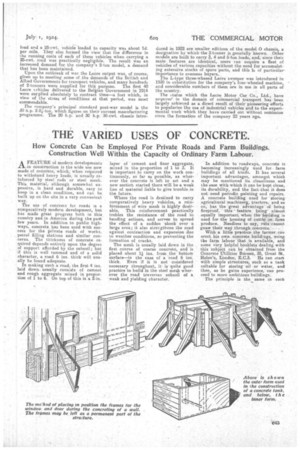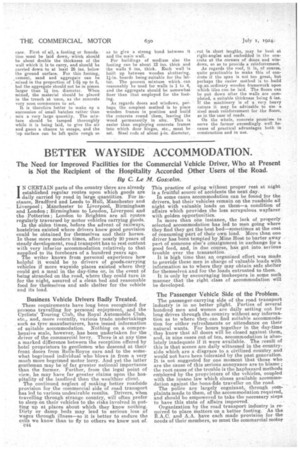THE VARIED USES OF CONCRETE.
Page 31

Page 32

If you've noticed an error in this article please click here to report it so we can fix it.
How Concrete Can be Employed For Private Roads and Farm Buildings. Construction Well Within the Capacity of Ordinary Farm Labour.
A FEATURE of modern developments construction is the wide use now made of concrete, which, when required to withstand heavy loads; is usually reinforced by steel rods or steel mesh. This material,although somewhat expensive, is hard and durable, easy to keep in a clean condition, and can be built up on the site in a very convenient way.
The use of conCrete for roads is a comparatively modern development, but has made great progress bath in this country and in America during the past few years. In addition to public highways, concrete has been used with success for the private roads of warks, petrol filling stations and similar concerns, The thickness of concrete required depends entirely upon the degree of support afforded by the subsoil; but if this is well rammed and of a solid character, a road 6 ins, thick will usually be found adequate. In making such a road, the first 4 ins. laid down. usually consists of cement and rough aggregate mixed in propor• tion of 1 to 6. On top of this is a 2-in.
layer of -cement and finer aggregate, mixed in the proportion of 1 to 3. It is important to carry on the work continuously, so far as possible, as wherever the concrete is left to set and a new section started there will be a weak line of material liable to give trouble in the future.
Where the road is destined to carry comparatively heavy vehicles, a reinforcement of wire mesh is highly desirable. This reinforcement practically trebles the resistance of the road to bending actions, and serves to spread the effect of a sudden 'shack over a large area; it also strengthens the road against contraction and expansion due to weather conditions, so preventing the formation of cracks.
The mesh is usually laid down in the first course of coarse concrete, and is placed about 14 ins, from the bottom surface—in the case of a 'road 6 ins. thick. Even if it is not considered necessary throughout, it is quite good practice to build in the steel mesh wherever the road traverses subsoil of a weak and yielding character.
In addition to roadways, concrete is becoming increasingly used for farm buildings of all kinds. It has several important advantages, amongst which may be mentioned its cleanliness and the ease with which it can be kept clean, its durability, and the fact that it does not nee-d periodic painting and repairs. A concrete building used for storing agricultural machinery, tractors, and so on, has the great 'advantage' of being fireproof, this 'feature being' almost equally important when the building is used for the housing of cattle.:ar farm produce. Needless to say, rats-cannot gnaw their way ,throngh conerete.
With a little practice the farmer can erect, his own concrete buildings, rising the farm labonr 'that is available, and some very helpful.b-ooklets dealing with this subject can be obtained from the Concrete Utilities Bureau, 35, Great St. Helen's, London, E.C.3. He Can start viith simple structures, such as a tank suitable for storing 'oil or water, and then, as he gains experience, can proceed to more ambitious buildings.
The principle is the same in each
case. First of all, a footing or foundation must be laid down,which should he about double the thickness of the wall which it is to carry, and should be carried down to at least 26 ins, below the ground surface. For this footing, cement sand and aggregate can be mixed in the proportion of 1-2i up to 5, but the aggregate should not be in pieces larger than 11 ins. diameter. When mixed, the material should be placed in the trench at once, as the concrete very soon commences to set.
It is therefore better to make up a succession of small batches rather than mix a very large quantity. The mixture should be tamped thoroughly while it is being laid, to give the air and gases a chance to escape, and the top surface can be left quite rough so
as to give a strong bond between it and the main wall.
For buildings of medium size the footing can be about 12 ins, thick and the walls 6 ins, thick. Each wall is built up between wooden shuttering, 11-in. boards being suitable for the latter. The poorest mixture which. can reasonably he used for walls is 1 to 4, and the aggregate should be somewhat finer than that employed for the footing.
As regards doors and windows, perhaps the simplest method is to place wooden frames in position and build the concrete round them, leaving the woad permanently in situ. This is easier than employing concrete frames into which door hinges, etc., must be set. Steel rods of about Fin. diameter, cut in short lengths, may be bent at right-angles and embedded in the concrete at the corners of doors and windows, so as to provide a reinforcement.
As regards the roof, it is of course, quite practicable to make Ails of concrete if the span is nat too great, but perhaps the easier method is to build up an.ordinary wooden framework upon which tiles can be laid. The floors can be put down after the walls are completed, a suitable thickness being 6 ins. If the machinery is of a very heavy nature it may be advisable to use a steel mesh reinforcement for the floors, as in the case of roads.
On the whole, concrete promisee to serve the farmer exceedingly well because of practical advantages bath in construction and in use.














































